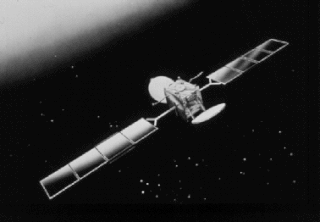Communications satellite
artificial satellite designed for telecommunications From Wikipedia, the free encyclopedia
Remove ads
Communications satellites are satellites stationed in space for the purpose of telecommunications. They relay radio waves between different places.[1][2] Most are in synchronous orbit. Direct-broadcast satellites transmit many television channels.

Satellite based communication systems can be used for voice and data transmission in remote and underserved locations such as ships at sea. Satellite internet access is internet access provided through satellites. Satellite based systems can be used for providing high quality broadband internet connection to businesses.
Herman Potočnik (writing as 'Herman Noordung') was the first to propose that space stations use radio to communicate with Earth. In October 1945 Arthur C. Clarke published an article titled "Extraterrestrial relays" in the British magazine Wireless World.[3][1] The article described artificial satellites in geostationary orbits to relay radio signals. So, Clarke is often quoted as being the inventor of the communications satellite.[4][5]
Primitive communication satellites were tested in the early 1960s. Geosynchronous satellites became important in the 1970s.
Remove ads
Types of Satellite Orbits
There are 4 main satellite orbits.
- Low Earth Orbit (LEO) - Between 160 km to 2,000 km from Earth surface and completes one orbit in 90 - 120 minutes[6]
- Geosynchronous Earth Orbit (GEO) - 36000 km from Earth
- Medium Earth Orbit (MEO) - Between LEO and GEO orbits
- Elliptical Orbit - A long, narrow orbit that spends much of its time over subarctic areas
Revisit Time
The time taken by satellites to visit the same point on earth again is called the revisit time. Revisit time can be shortened by combining data from multiple satellites.[7]
Remove ads
Other uses of Communication Satellites
In addition to transmitting data, Modern satellites have;
References
Wikiwand - on
Seamless Wikipedia browsing. On steroids.
Remove ads
